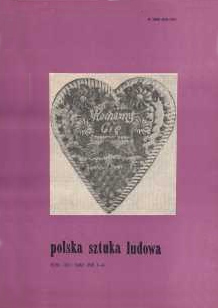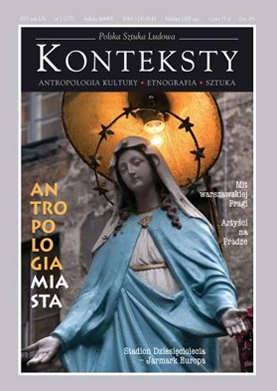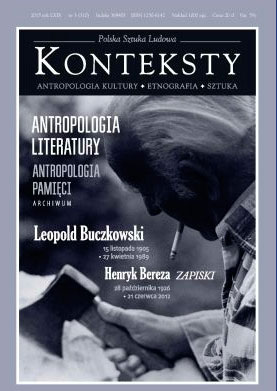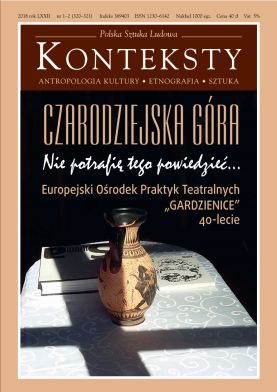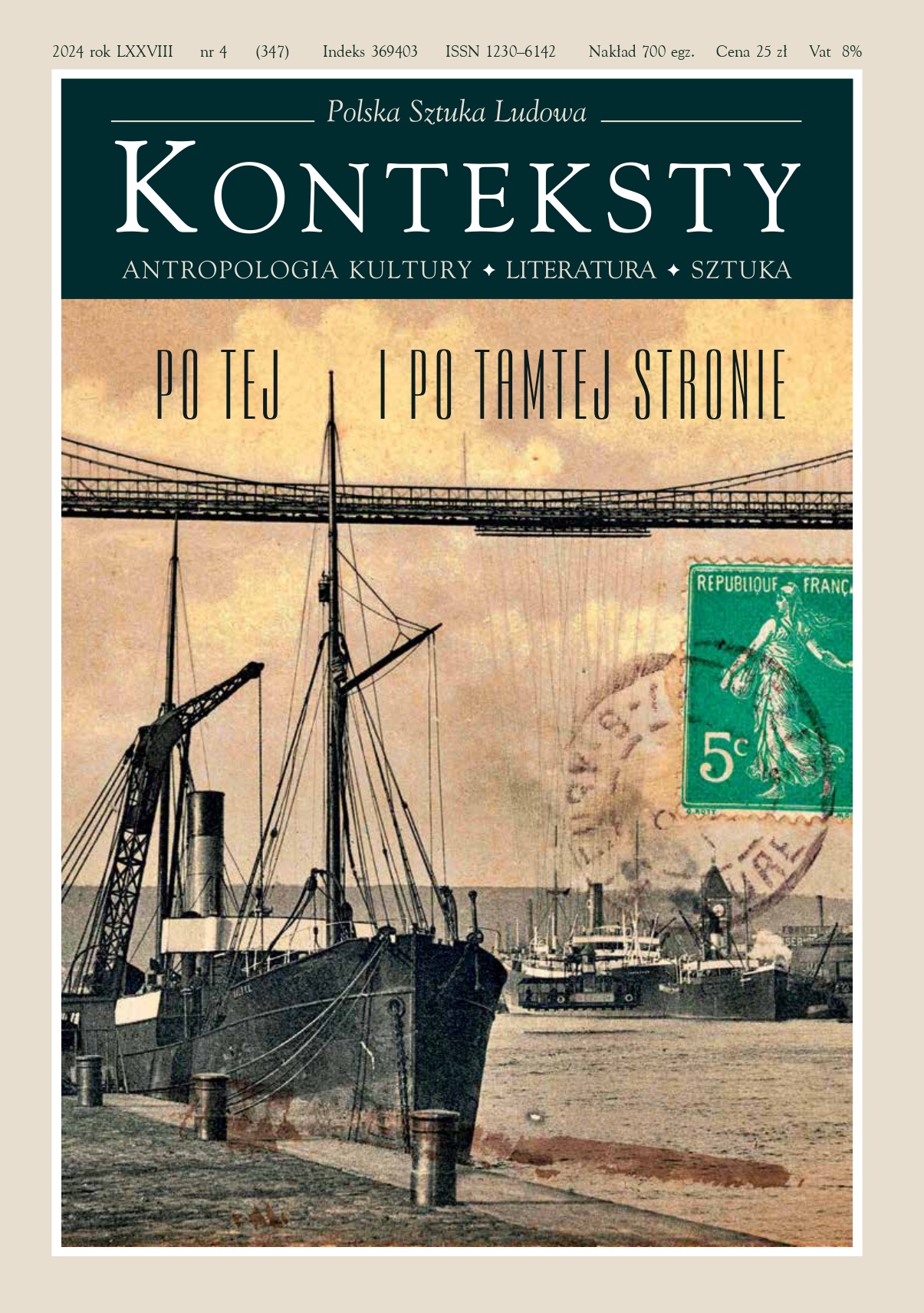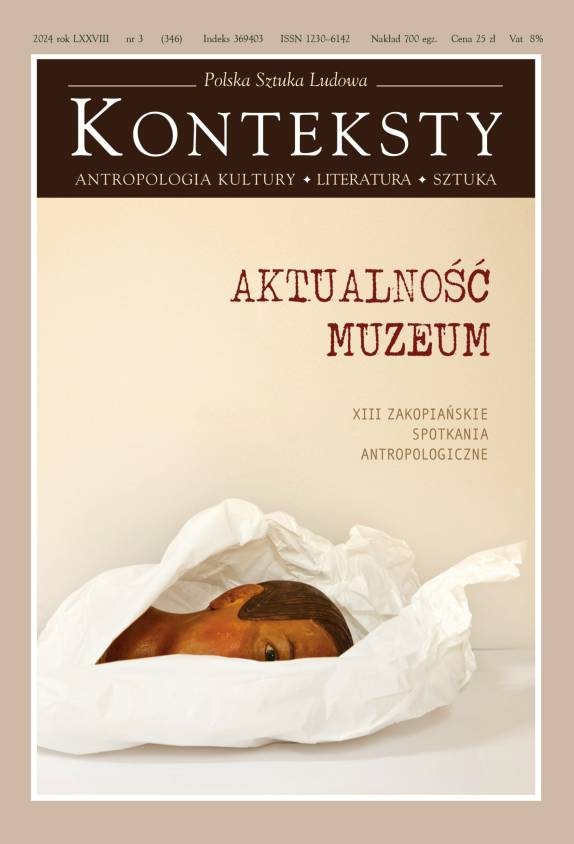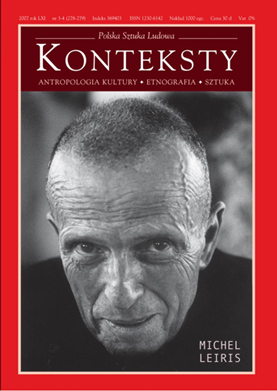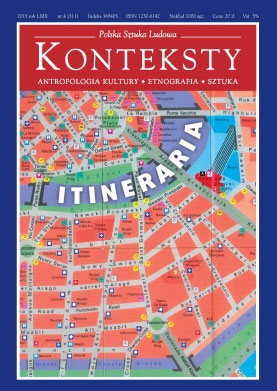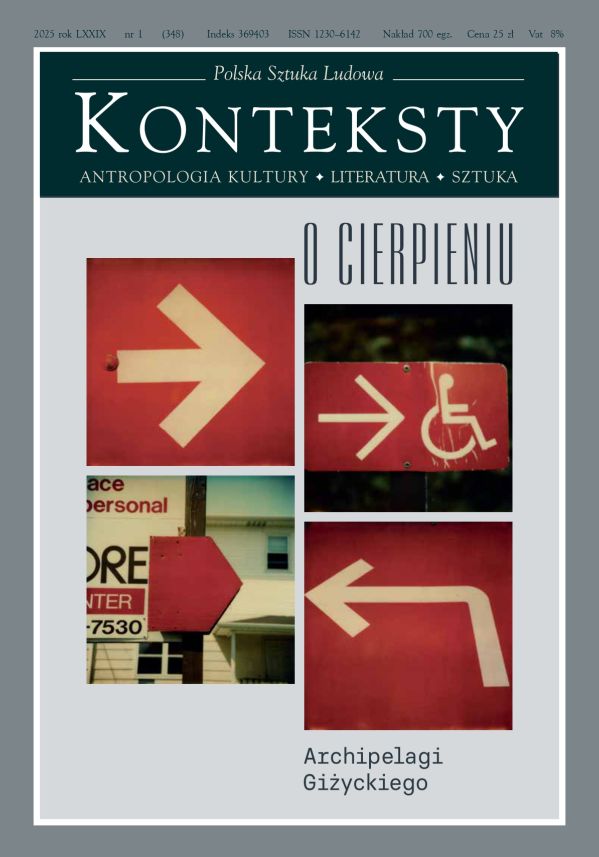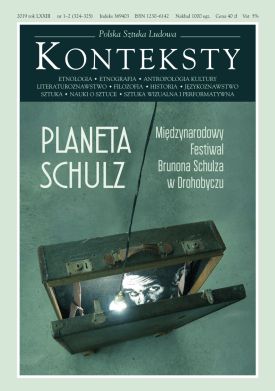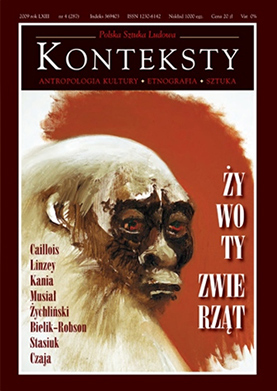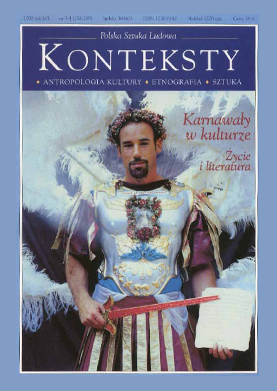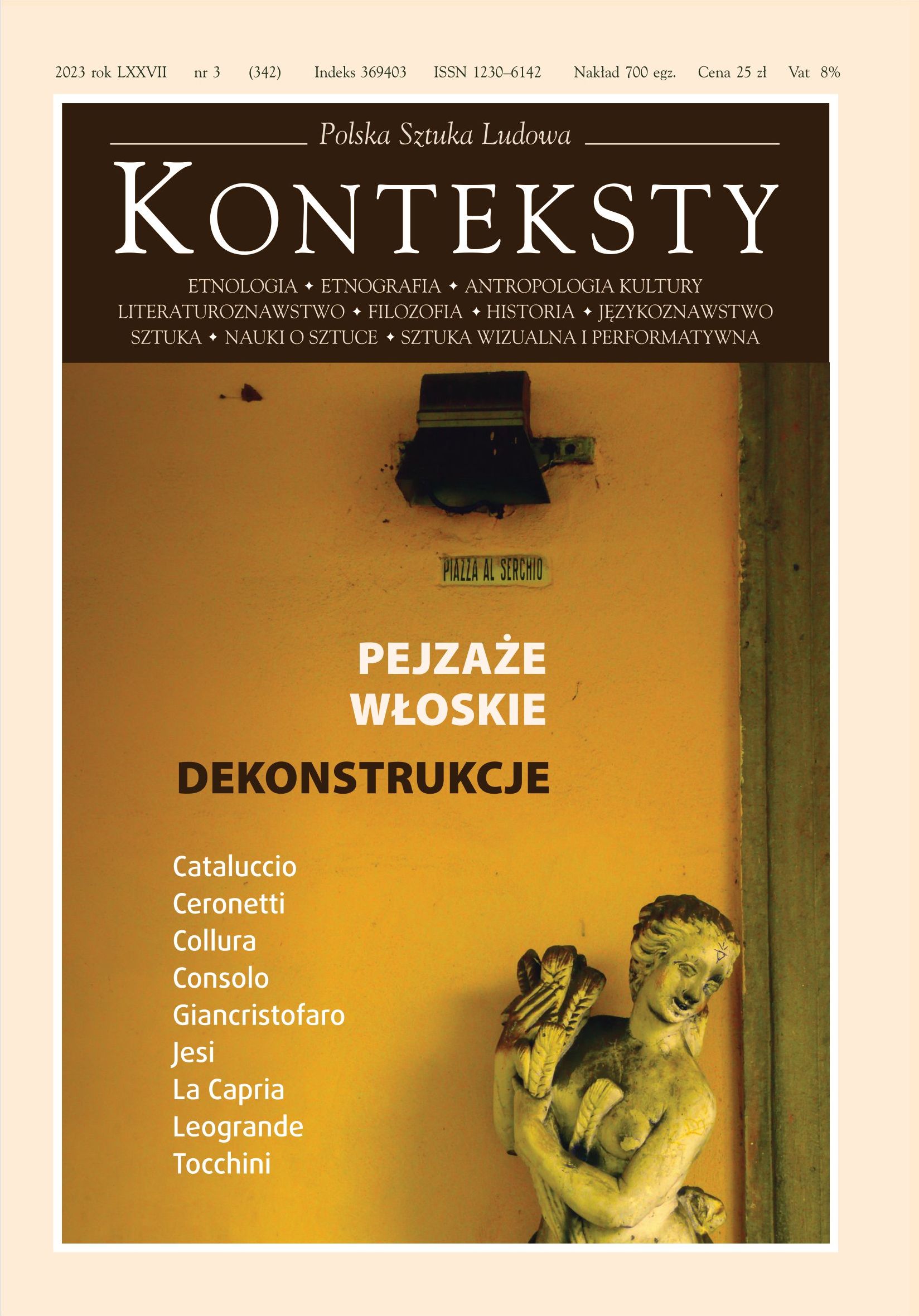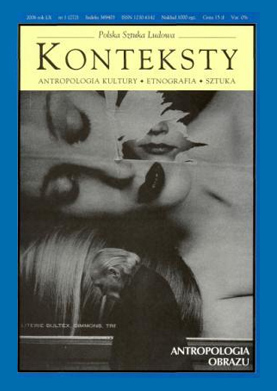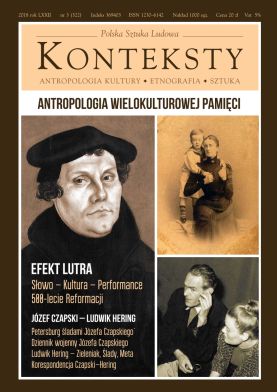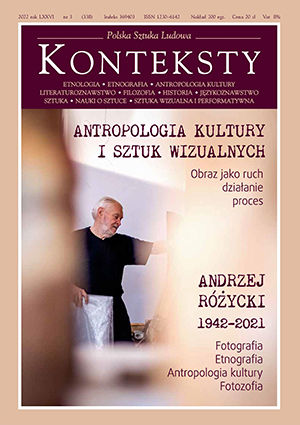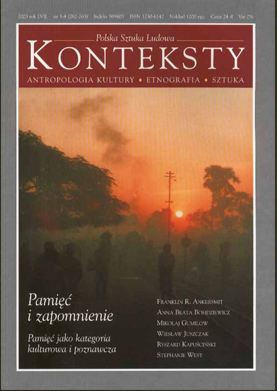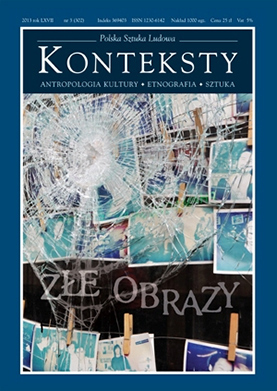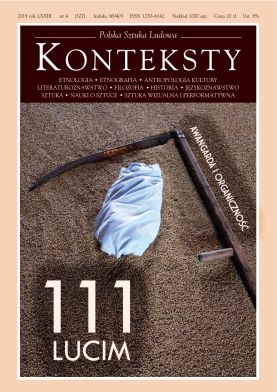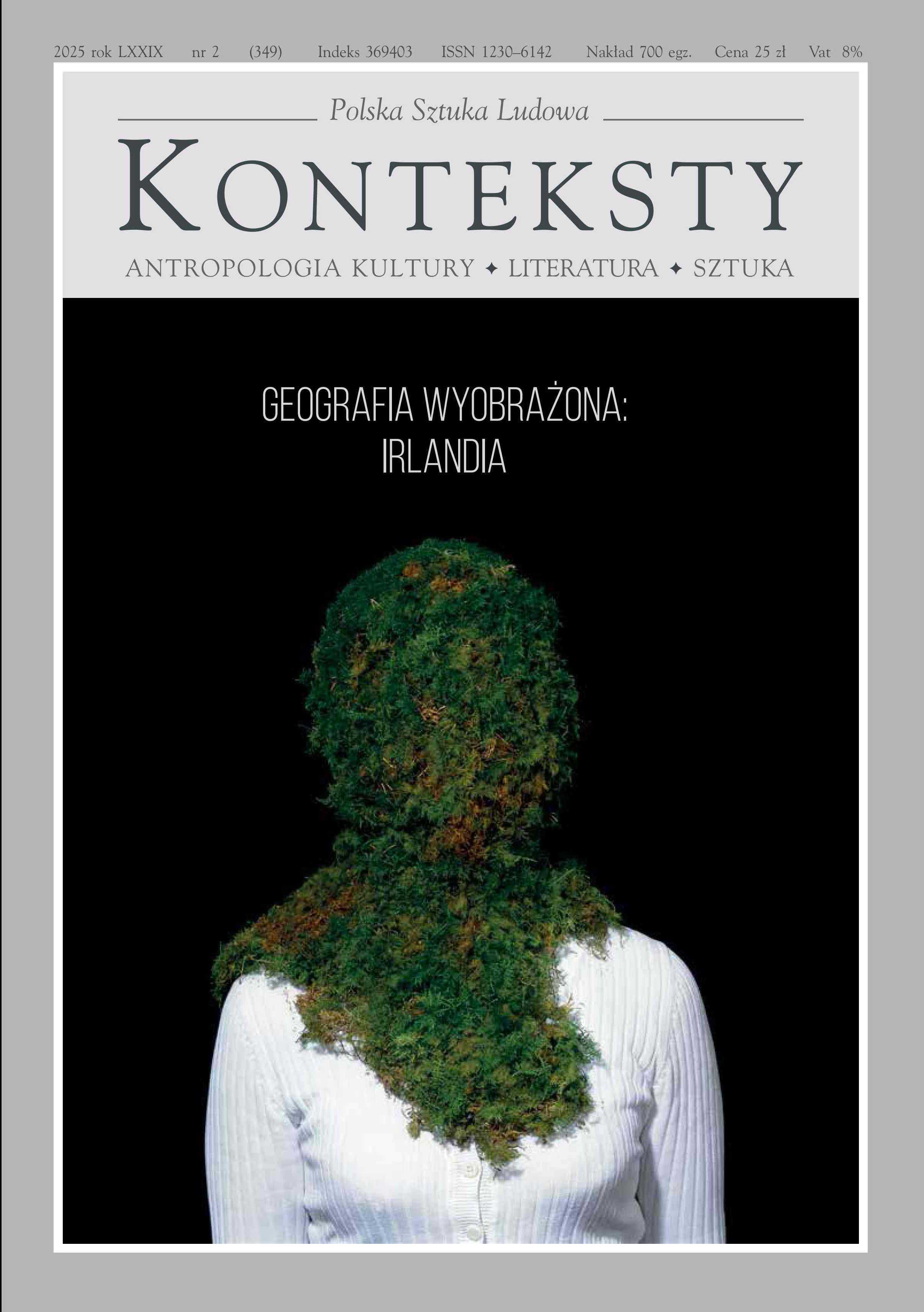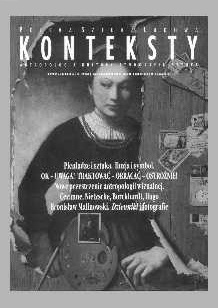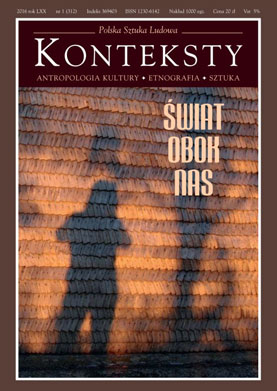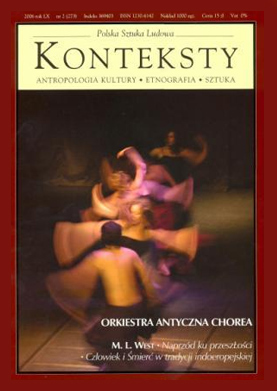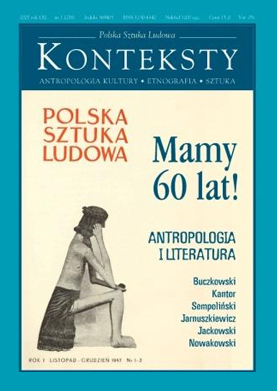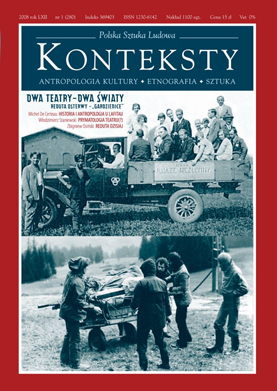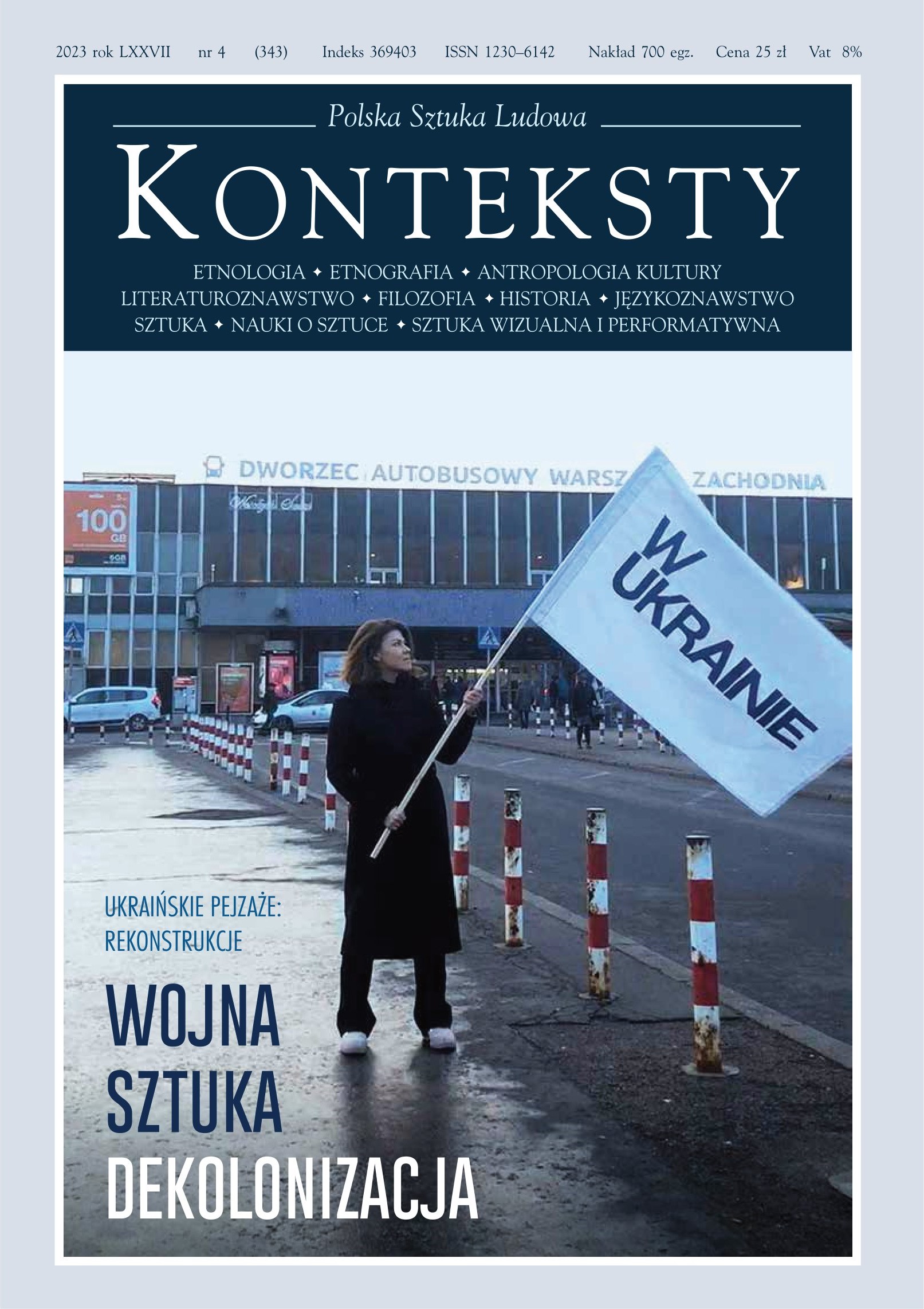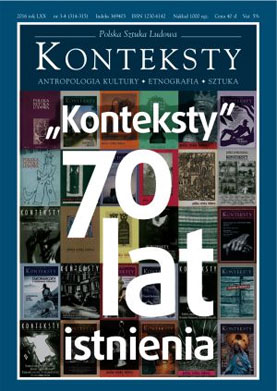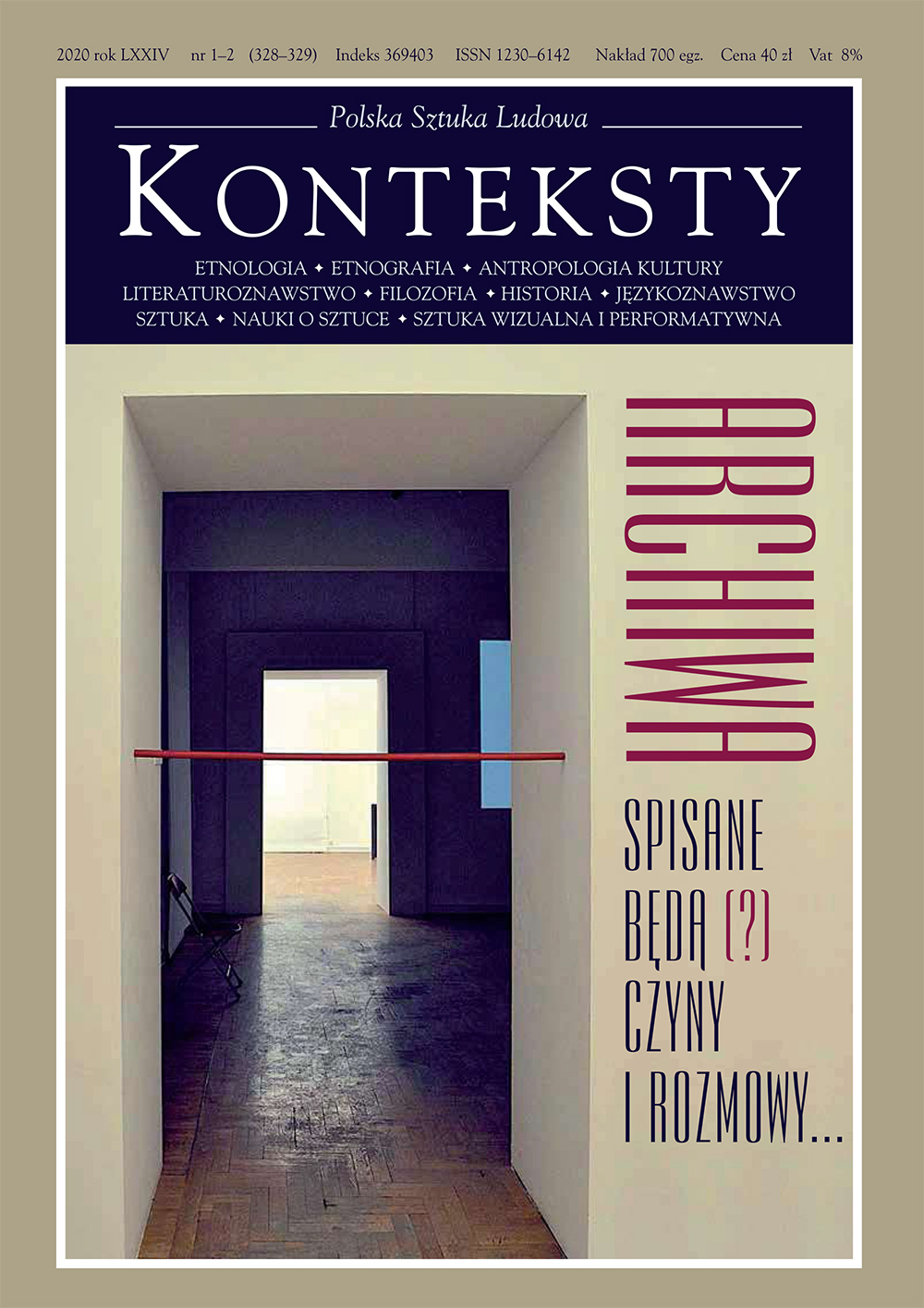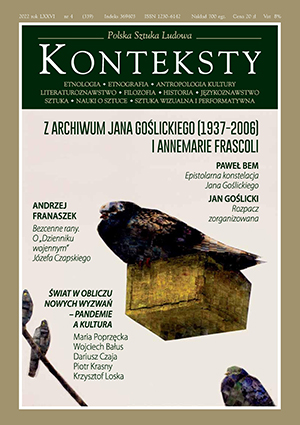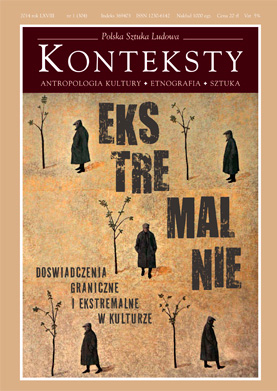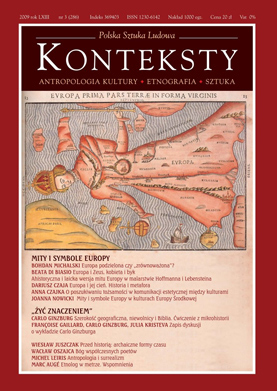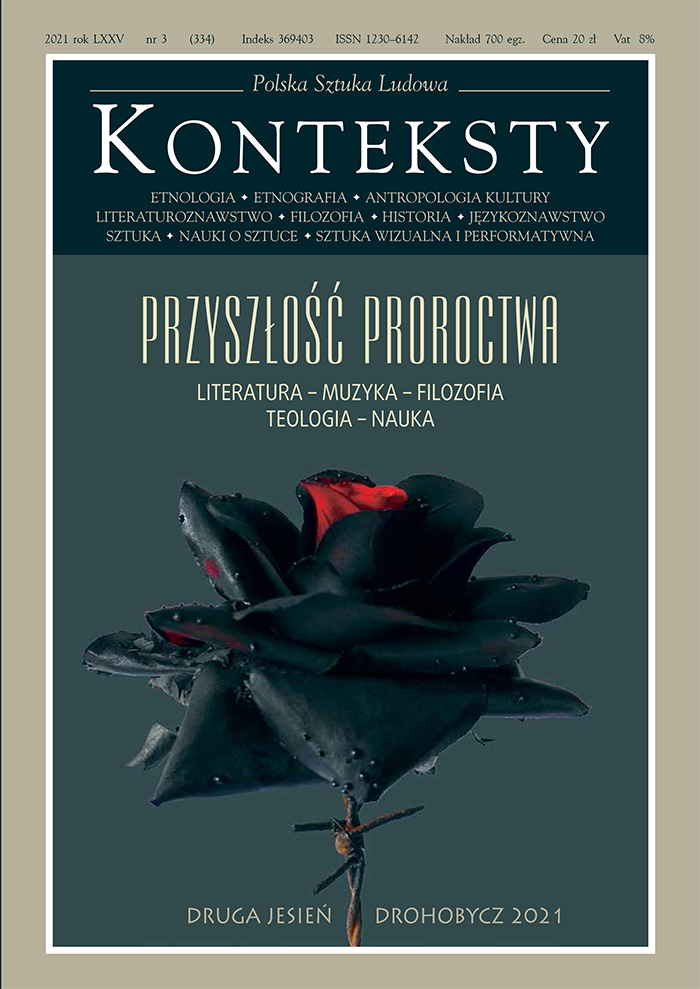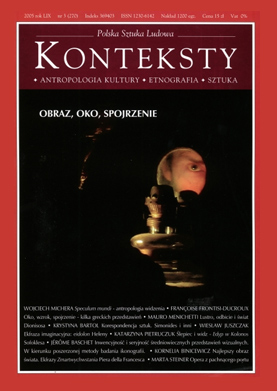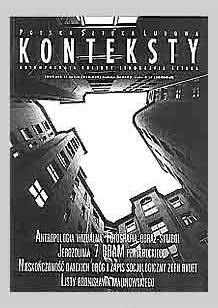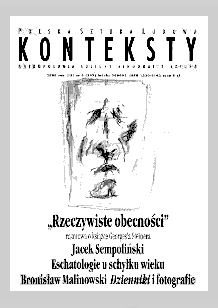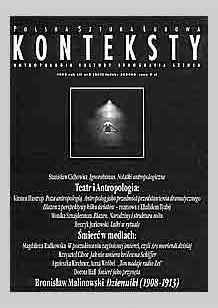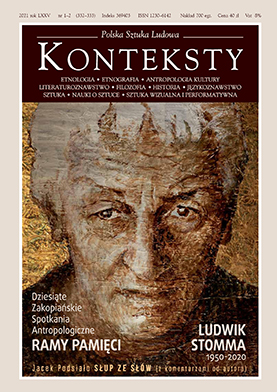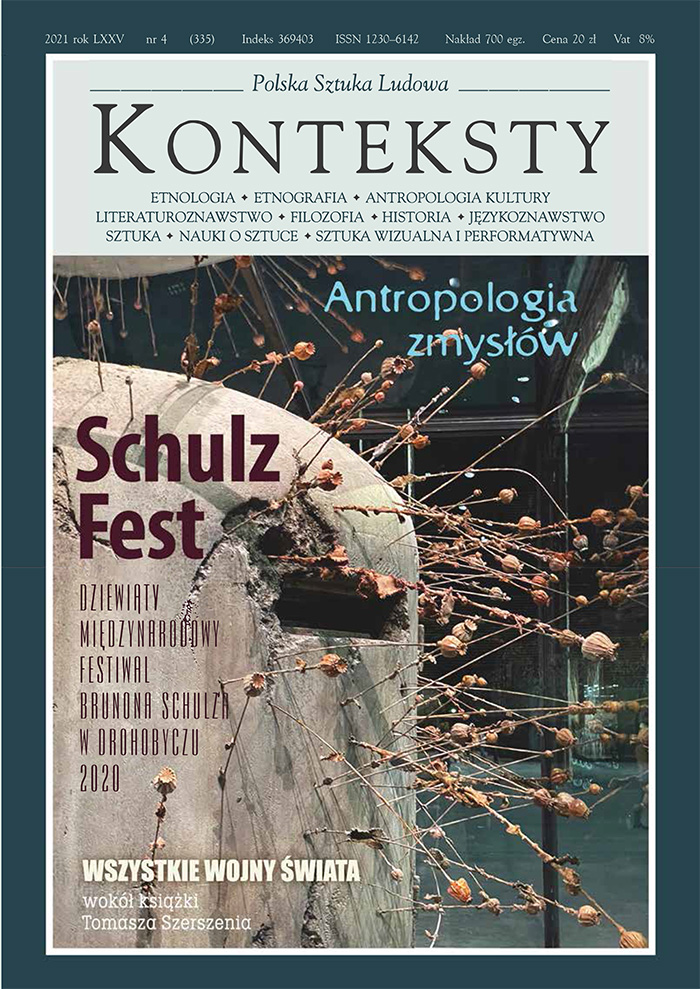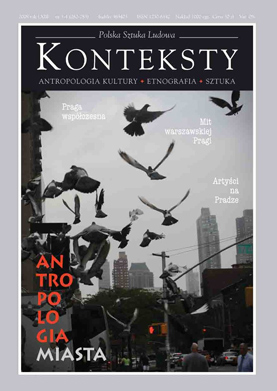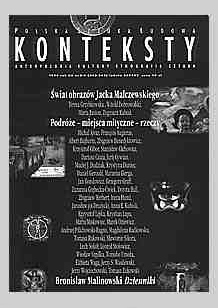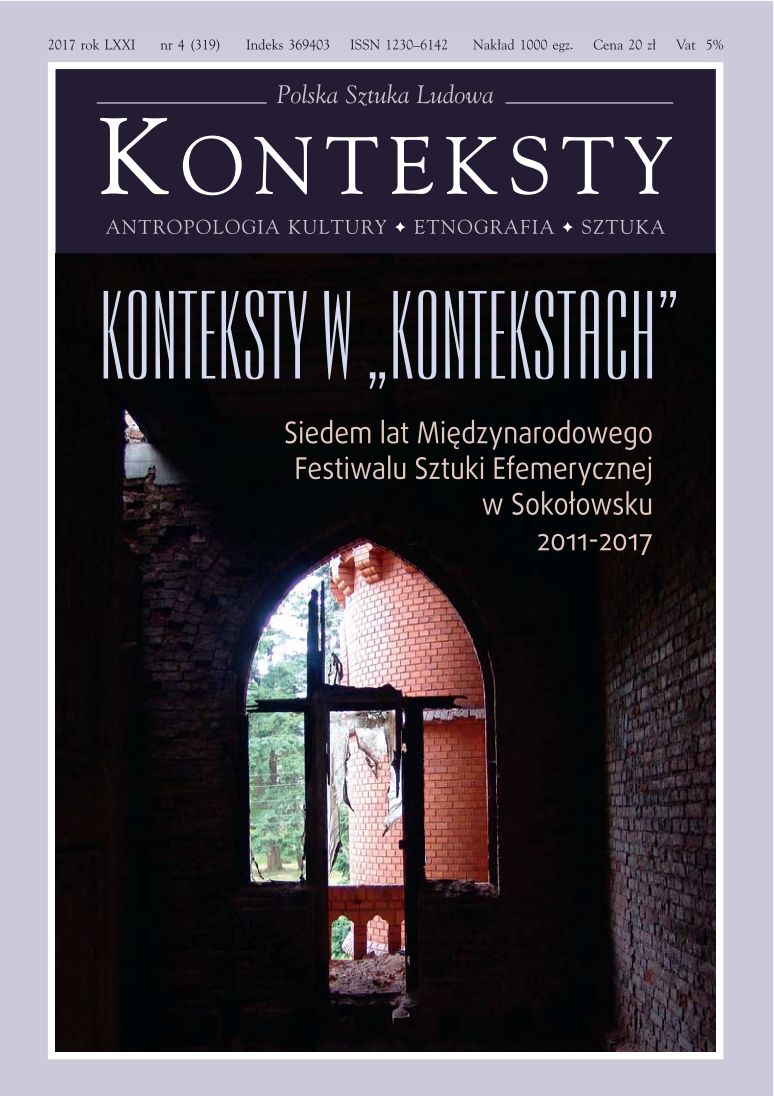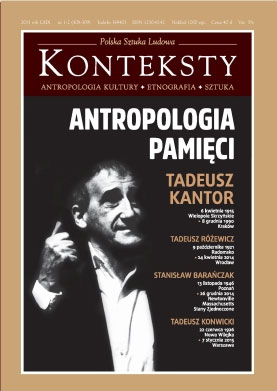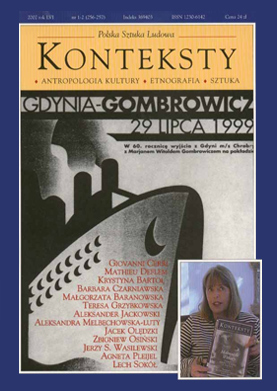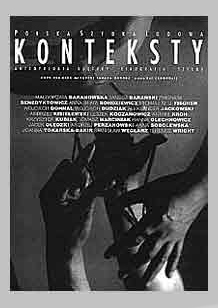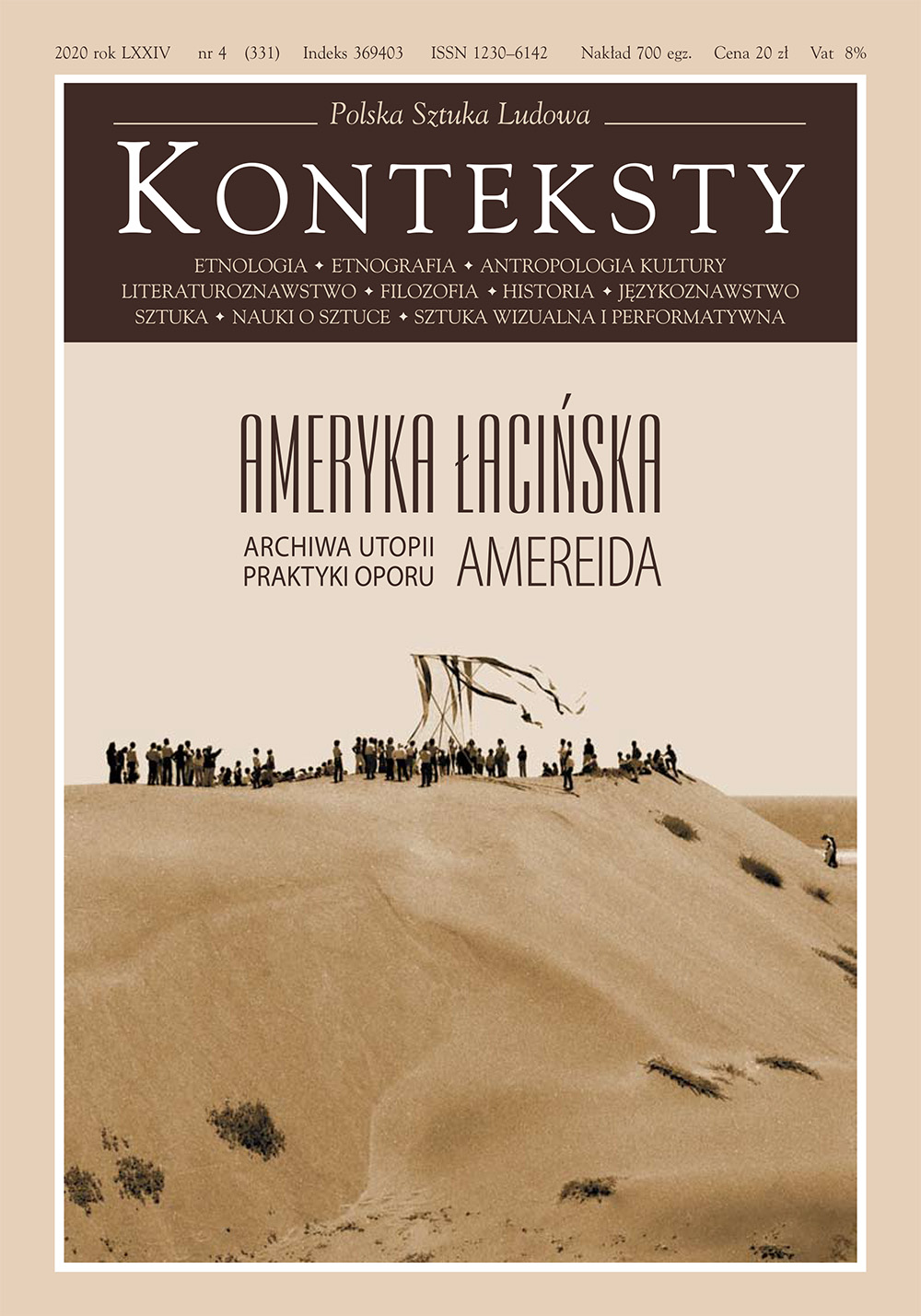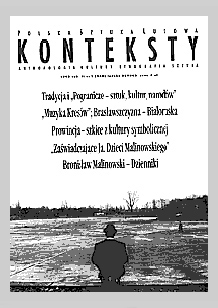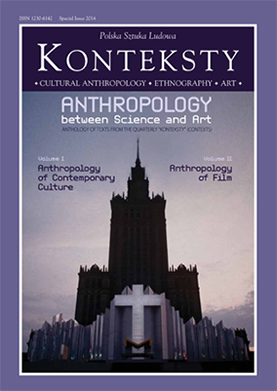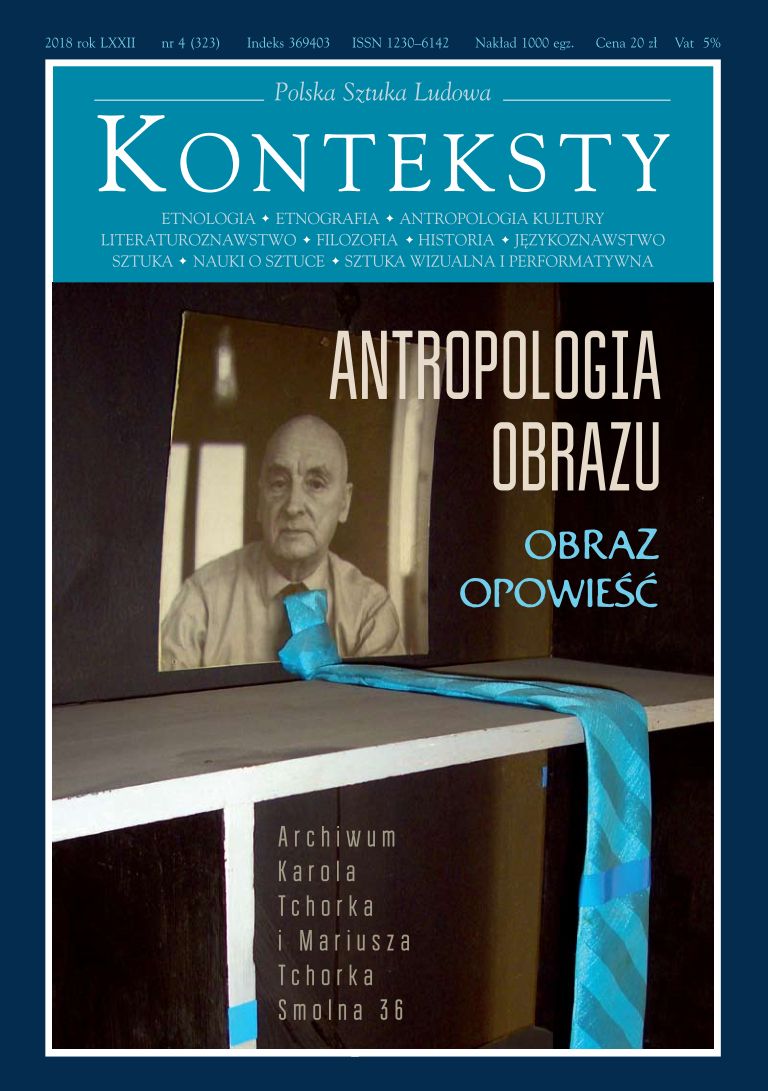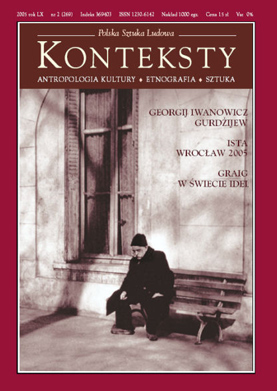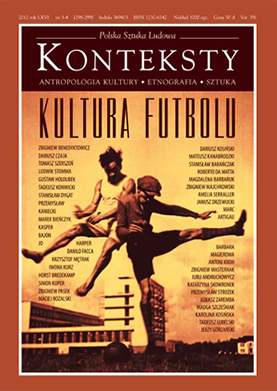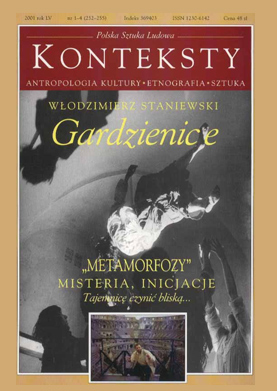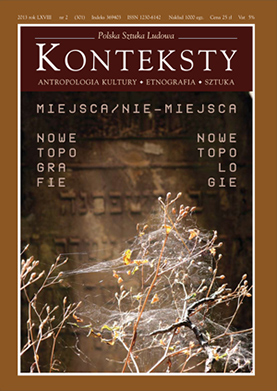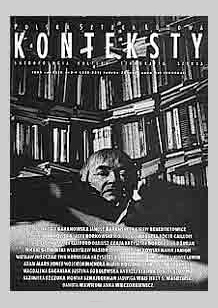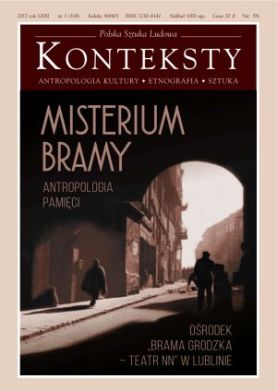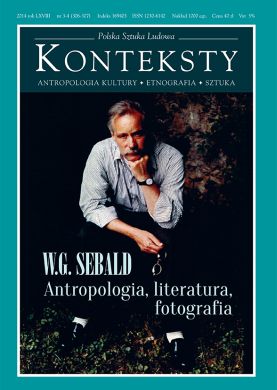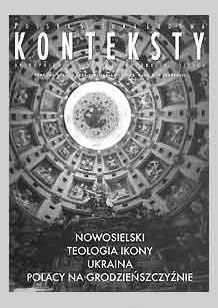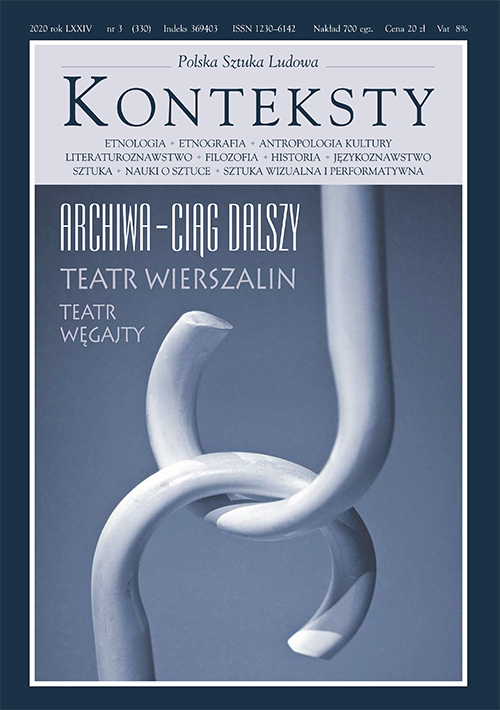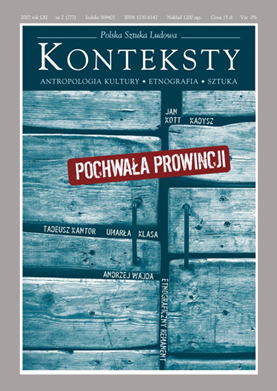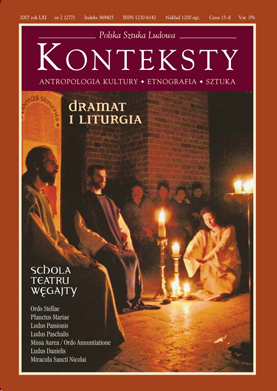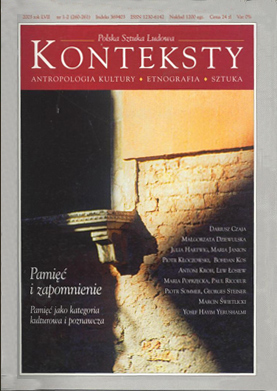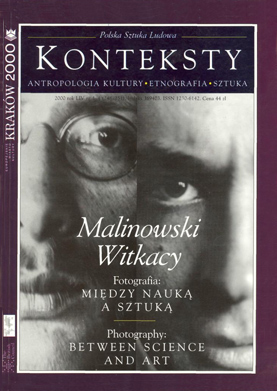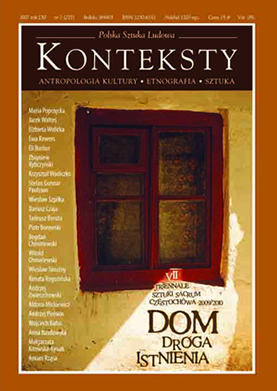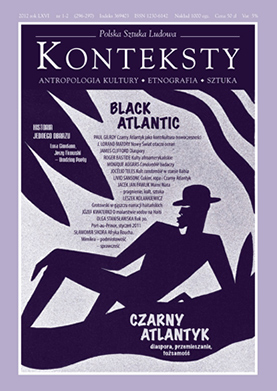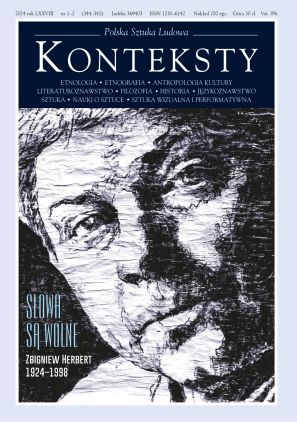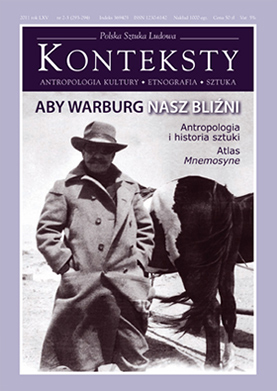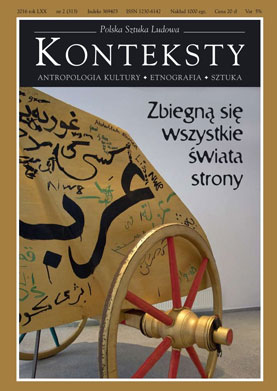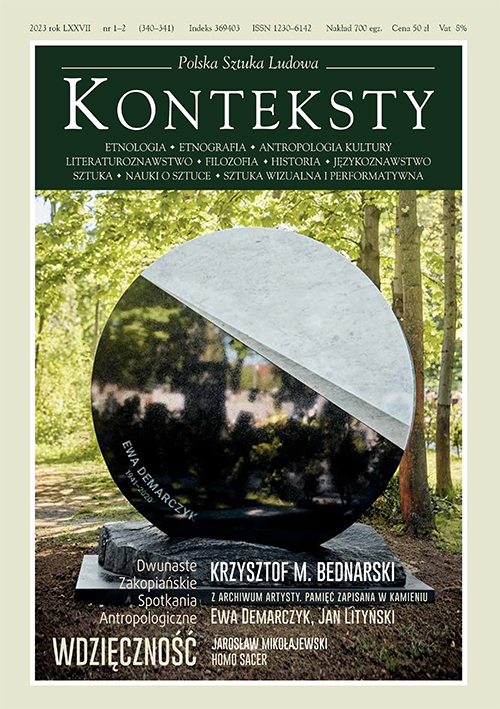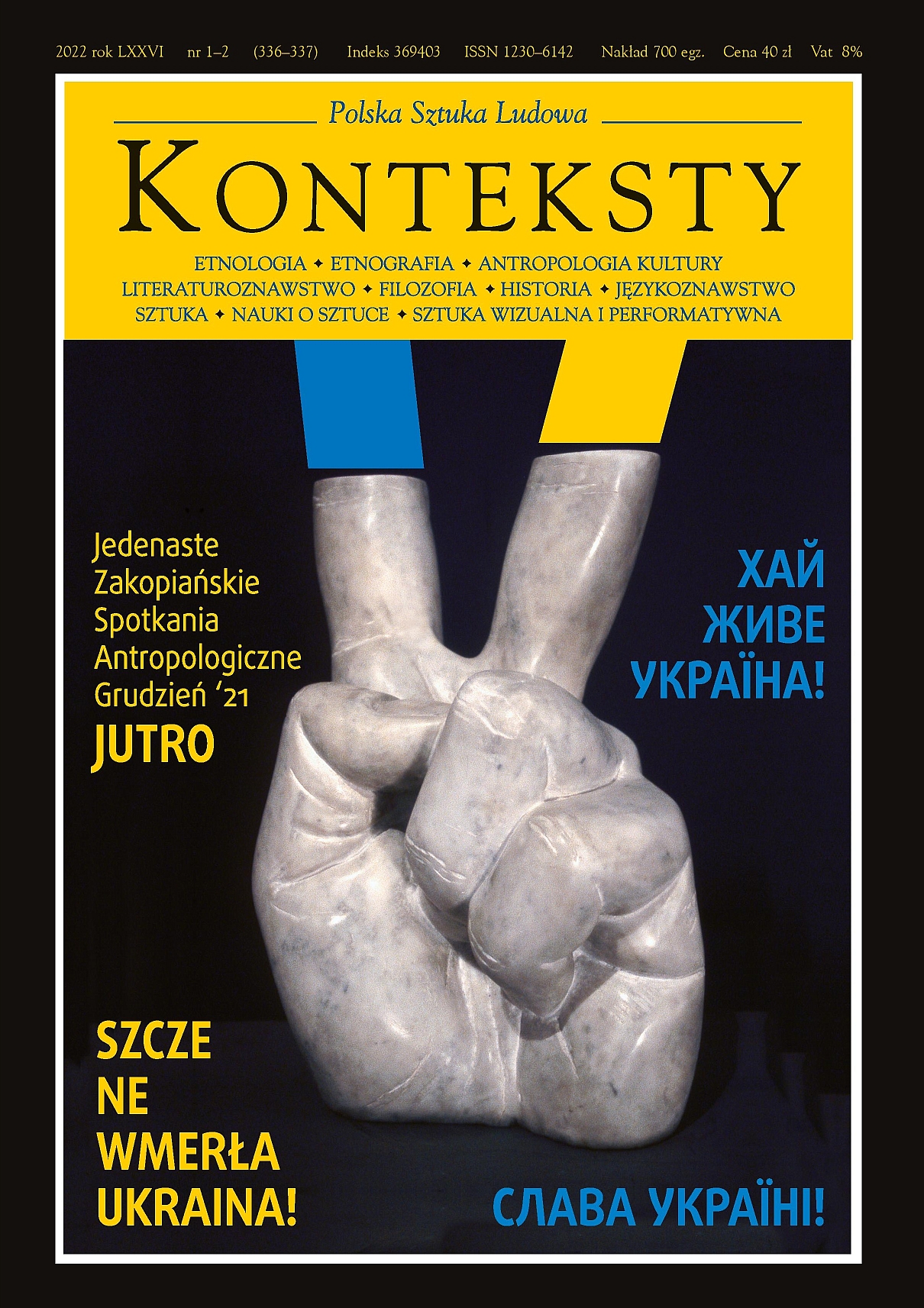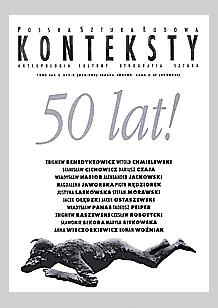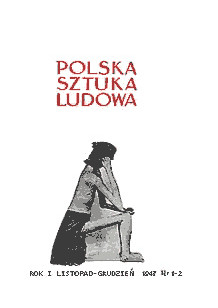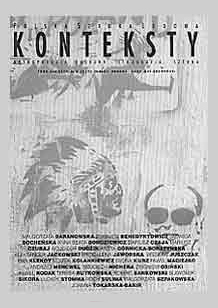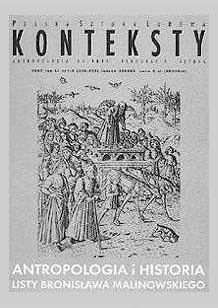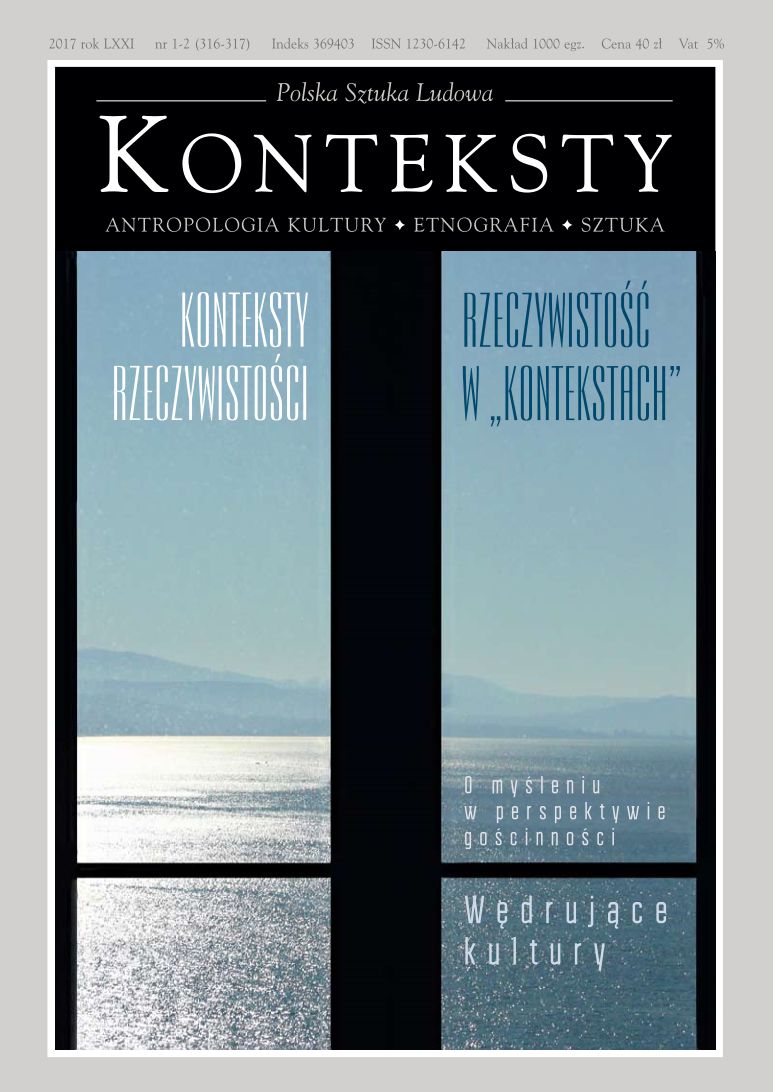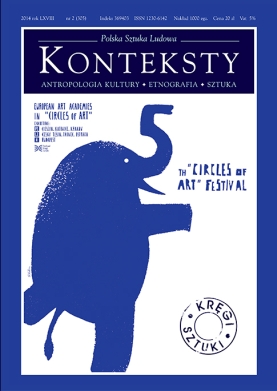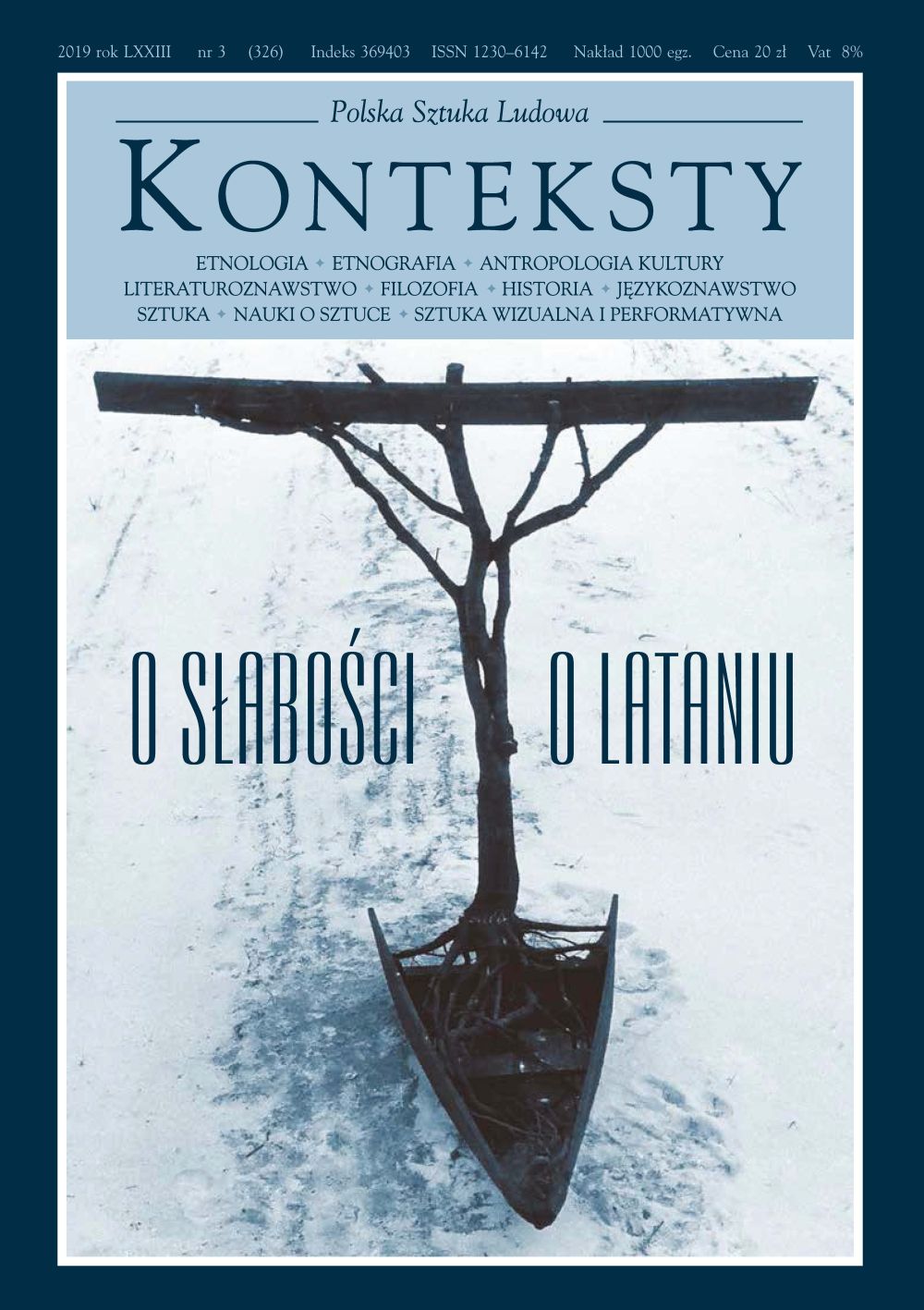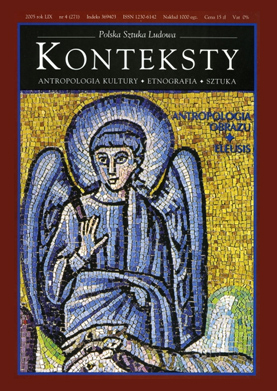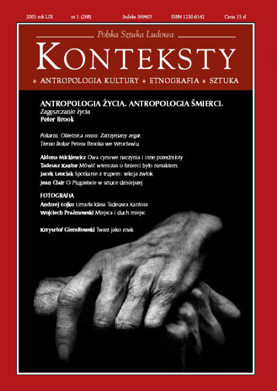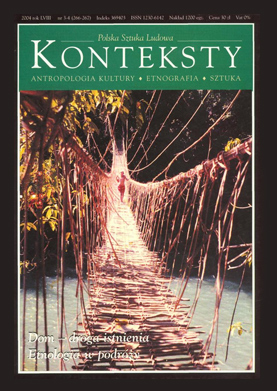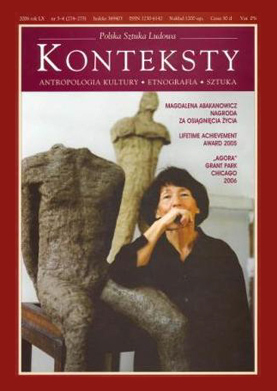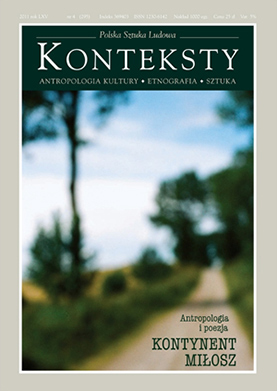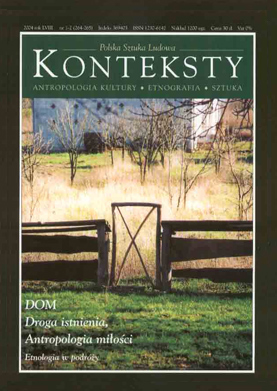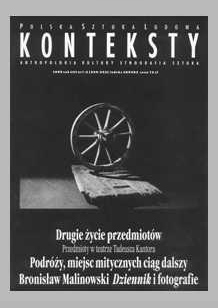Issue 2013/1 (300) - Konteksty

Read the whole issue online  | ||
Download PDF file. | ||
| *** | ||
| Maria Poprzęcka | 6 | |
| Elżbieta Barbara Zybert | 8 | |
| Elżbieta Wolicka-Wolszleger | 10 | |
| Waldemar Okoń | 12 | |
| Czesław Robotycki | 15 | |
| Wiesław Juszczak | 19 | |
| Dariusz Czaja | 21 | |
| Wiesław Juszczak | 34 | |
| *** | ||
| Zbigniew Benedyktowicz | 35 | |
| Janusz Barański | Highlander Culture and Memory  | 38 |
The point of departure for this article is the Polish highlander culture of the Podhale region, an exceptional case of local culture and a valuable laboratory of cultural constancy and change. For those reasons, this particular culture also became a sui generis domain of a theoretical dispute about the comprehension of such phenomena as tradition/modernity, continuum/change, authenticity/non-authenticity, and the autotelism/instrumentalism of culture. The dispute also enters the range of the obligations of the researcher threatened with a confrontation with methodological dilemmas along the cognitive objectivism/subjectivism, distance/involvement, etc. axis. The above problems compel him to pursue reflections about the meanings of basic terms and concepts serving the description/explanation of cultural phenomena. This hold true in particular for the context of folk qualities, whose explanatory usefulness does not decrease albeit its meaning content succumbs to changes calling for methodical recognition and use in the scientific discourse. | ||
| Jan Gondowicz | Demonic Zakopane – Myth and Fact  | 47 |
Zakopane – the only Polish locality considered to be demonic – emerged 130 years ago as the utopian project of visitors representing the Polish intelligentsia. Justification for this opinion was sought in assorted sources: Zakopane was supposed to possess the qualities of a health resort, provide foundations for new social harmony, and become the fount of a revival of national sturdiness and supreme “racial” ideals, an artists’ colony, and a site for the abolition of the antinomy of nature and culture. The fiasco of this vision was accompanied by a growth of the “dark” mythology of Zakopane, still alive today, first envisaged as a place for the suspension of “normalcy” for the sake of individualism (Witkacy) and next as a decadent community with an underpinning of irony (Rafał Malczewski). Thus comprehended miasma of Zakopane isolated the local residents within the range of their esoteric, incomprehensible and indissoluble problems, whose in-depth examination threatens the psychic equilibrium of the inhabitants of the lowlands. | ||
| Antoni Kroh | The Tatra Museum – First and Last Love  | 51 |
A sentimental and simultaneously anecdotal reminiscence about the Tatra Museum in Zakopane, where the author worked as an ethnographer in 1967-1970; he remained loosely connected with this institution for more than forty years. We read about people, ambiance, changing outer conditions, and problems associated with the protection of folk art from the Podhale region. | ||
| Maciej Krupa | Zakopane is a School of Longing  | 78 |
The author analysed the names of hotels, guesthouses, villas and restaurants in Zakopane from the beginnings of the resort to the present day. Up to the First World War they described the world of Zakopane in the categories of a province, but in the interwar period the number of names designating affiliation with the great world and the centre grew, thus disclosing a provincial mentality. This trend is continued to this day, indicating that Zakopane remains provincial and for this reason, to cite Sławomir Mrożek, is a “a school of longing”. | ||
| Zbigniew Benedyktowicz | 85 | |
| Kuba Szpilka | Following Traces – About the Residents of Zakopane in Search for Identity  | 99 |
A presentation of Zakopane qualities as a cultural phenomenon constantly created by the local inhabitants – a narration about existence between Mt. Giewont and Gubałówka Hill, with a town in the middle. This is a story written by resorting to human fate and efforts at its comprehension as well as material monuments – the outcome of work and events. | ||
| Wojciech Michera | Residents of Zakopane and the Nekyia  | 105 |
In their programme text the authors of the exhibition: Residents of Zakopane in search for identity refer to the category of the “fragment”, defining the latter in a manner proposed in the book by Dariusz Czaja (“sometimes fragments may indicate the whole”). The author of the article agrees that the “poetic of the fragment” is important for the narration of the Zakopane exposition but proposed, by way of a example, a decisive radicalisation of the manner of its comprehension. In his interpretation, the fragment is an irreducible aspect of the image, including a photographic one; it is a diffraction force that while shattering the illusion of a whole does not offer anything in return but only endlessly multiplies particular frames and “fissures”. | ||
| Piotr Mazik | The Role of Photography in History  | 108 |
Do we delve into history whole looking at photographs? Do we take them while thinking about writing history? Roland Barthes extracted the difference between participation in history and its study. The parallel nature of those activities is probably impossible. The division into the moment of taking a photograph – recording reality and watching it, i.e. transition into history, is much too simple. The role played by the photograph in history, its recording, deciphering and deformation is highly ambivalent. Hence the form of this text is somewhat unsteady and mosaic-like, and derived of the inner light that breaks through chaos. It introduces anxiety, just as in the case of the object of its interest. The fleeting nature of photographs forces us to assume an erroneous interpretation, the role of an accident, and distracts attention focused on the theme and the author’s intentions, the creation of the portrayed. Photographs, however, still continue to be the most universal manner of recording, an imprint of reality. Aware of the fleeting nature of memory and how written history does not adhere to the world, which we recall or in whose appearance, we believe, the photograph is the only possible way. | ||
| Wojciech Szatkowski | Goralenvolk – an Identity Crisis  | 115 |
The text attempts to resolve several questions. Who betrayed and why? Who created the theory about the Teutonic origin of the Polish Tatra Mts. highlanders? At the time of the Nazi occupation Goralenvolk was the most significant and largest organised form of collaboration in Poland. This certainly black page in the history of the Podhale region has been rarely discussed. Rejected, it gives rise to various emotions and for years has been surrounded by a sui generis conspiracy of silence. Unsurprisingly, the topic is not readily broached in Podhale, an attitude that was conducive for the communists, on the one hand, and for the surviving participants of the wartime events, on the other hand. Censorship effectively assisted in this conspiracy of silence and Goralenvolk was mentioned in few scattered, fragmentary and low-circulation publications. Praise is due to those authors who endeavoured to write about it, i.a. Janusz Berghauzen, Henryk Jost, Sylwester Leczykiewicz, Adam Palmrich, and Włodzimierz Wnuk. The first monograph on the history of Goralenvolk appeared 66 years after the war: the book by Wojciech Szatkowski demonstrates the mechanisms of treason. | ||
| Stanisława Trebunia-Staszel, Małgorzata Maj | Nazi Anthropological and Folklore Studies in the Podhale Region. Document and Memory  | 122 |
The authors are interested in the documentation created at the time of the Second World War by the Nazi Institut für Deutsche Ostarbeit in Cracow, and predominantly by one of its sections – Sektion Rassen und Volkstumforschung, involved in anthropological and ethnographic studies focused on selected groups of the population of the General Government, including highlanders of the Podhale region. The prime task of the project realized by M. Maj is to examine and partly verify heretofore knowledge about the work performed by Sektion Rassen- und Volkstumforschung IDO in Podhale during the 1941-1942 period upon the basis of an extensive collection of previously unknown documents, in 2008 entrusted to the Jagiellonian University Archives. At the same time, by referring to accounts by still living persons (at the time, school children) subjected to anthropological and medical examinations, the authors tried to demonstrate the way in which the campaign conducted by Nazi anthropologists left an imprint upon the children’s memory. | ||
| Aleksandra Melbechowska-Luty | Several Recollections about the Zakopane Wood Industry School and Its Carvers 1876-1939  | 141 |
The Wood Industry School opened in Zakopane in 1876 was an important centre of teaching construction, furniture production and carving. During the nineteenth century the Tatra Mts. and the Podhale region, together with their pantheistic landscape, were conceived as “sacred space”, a terrain that in contrast to big city culture attracted numerous outstanding authors, i.e. the instigator of the “Zakopane style” Stanisław Witkiewicz, Tytus Chałubiński, and Karol Szymanowski. For long, the school existed within the Austrian partition area and its first headmasters: Franciszek Neužil and Edgar Kováts taught according to methods imposed by Vienna, thus recommending the emulation of Alpine design. A genuine breakthrough came with Karol Stryjeński (1923-1927), who restored the prominence of the local art of Podhale, stimulated the pupils’ imagination, and developed their inborn talents. In 1938 another rebirth of the school was achieved by Antoni Kenar, who from 1947 was head of the State Secondary School of Art Techniques. Eminent artists who proved permanently influenced by Zakopane and the Tatra Mts. region included Jan Szczepkowski, a sculptor enamoured of folk carving; using the system of “highlander wedges” he executed in pine wood, i.e. the Nativity Shrine, winner of the Grand Prix at the Paris exhibition of 1925. | ||
| Urszula Makowska | The Zakopane Berghof  | 147 |
A medical institution in Zakopane for “those suffering from chest ailments” established and headed in 1902-1918 by Kazimierz and Bronisława Dłuski was the first tuberculosis sanatorium in the Polish high mountains. Its building referred to the architectural conception of an ideal sanatorium conceived by Dr. Karl Turban from Davos, and the interior arrangement and equipment corresponded to European standards. Therapy and the patients’ daily schedule also did not differ from Swiss norms, and thus even the details of the Zakopane-based institution resembled the Berghof described by Thomas Mann in The Magic Mountain. The distinguishing features of the Polish sanatorium against the background of similar institutions across Europe were the outcome of the ambitions of its authors, who decided to render it not only an exemplary centre using almost exclusively local products but also a showpiece of Polish art. This is the reason why the design of the generally accessible interiors was entrusted to artists – Jan Rembowski, Karol Frycz, Henryk Uziemblo and Wojciech Brzega. In this fashion, the sanatorium became a prolongation of a literary-art salon, whose role was played at that time by Zakopane. The establishment of the sanatorium coincided with an outbreak of animosity amidst the authorities and residents of Zakopane towards patients suffering from tuberculosis, whose presence could have deterred potential visitors. At the beginning of the twentieth century the tuberculosis myth, questioned and incapacitated in The Magic Mountain, still remained real in the Tatra Mts. resort despite, or because of the fact that this was the site of a first attempt at a successful battle against the disease in Poland. | ||
| Antoni Beksiak | 167 | |
| Maria Małanicz-Przybylska | Does Highlander Culture Exist…?  | 172 |
The essay attempts to consider the justification of present-day mention of highlander culture. The accepted perspective obligates to situate the culture in question along the crossroads of an imposed discourse and individual choices (at times accepted unthinkingly) of a certain “traditional” lifestyle. Does the titular highlander culture really exist? How should this concept be comprehended? What does it mean for the contemporary inhabitants of the Podhale region? The author sought a response for thus formulated questions by referring to the history of Podhale, the role of the intelligentsia in moulding the highlander identity, as well as the strategy, activity and views of the contemporary residents of Zakopane and nearby localities. | ||
| Bohdan Michalski, Beata Di Biasio | Zakopane, Poland, Europe: the Provincialism and Universalism of Władysław Hasior  | 178 |
The authors analysed the secret of the workshop of W. Hasior, which consists of a synthesis of the local, provincial and folk with the universal, the archetypes of Greek mythology that the artist carefully studied. Hasior expressed the great dramas of the Greek deities by resorting to the most common material borrowed from the fairground refuse heap of daily life. In doing so, he transposed the classical myth into the sensitivity of the contemporary recipient. | ||
| Barbara Major | 182 | |
| Łukasz Kossowski | Let’s Talk about Women. Schulz, Witkacy, Gombrowicz et al.  | 188 |
The Let’s Talk about Women... exhibition at the Tatra Museum in Zakopane should have been open only to members of the public aged over 18. Instead, it became a vacation joke, a discourse about the women of a number of outstanding artists: Schulz, Witkacy, Gombrowicz, Makuszyński, Lebenstein, Sroka… I looked at women worshipped, demanding constant homage, and followed closely by timid Bruno Schulz or those situated alongside Gombrowicz: emancipated and modern doctors’ wives from Wilcza Street, portrayed in Oligofrenie by Grzegorz Moryciński. In turn, the “bathing paintings” by Jacek Sroka are unique, grotesque paraphrases of the eternal motif of the female bather. The complicated love life of Witkacy was illustrated with magnificent photograms of the assorted ladies associated with this artist, borrowed from the collections of Lech Okołowicz and with professional glossa by Jan Gondowicz. The episode of an encounter with a she-bear described by Witkacy in Pożegnanie jesieni inspired the authors of the exhibition to show a designate of the story – a bear in an apiary, on show in the Museum collections. The culmination point of the exhibition was a display of paintings by Jacek Sroka, a contemporary Savonarola confronting ideological feminism. One of his works features immediately above some generous female buttocks an image of Che Guevara, the ultimate revolutionary icon. | ||
| Jerzy S. Wasilewski | Ethnologist on the Road 8: Mandar, an Extraordinary Man  | 193 |
Ethnographer’s dilemma: to construct his ethnography on what is average and typical for a given society/culture, or, rather, to look for those outstanding, unusual individuals. And, to what extent might their particular experiences be considered representative. One of such unique personalities is Mandar Uus, a Sakha (Yakut) blacksmith, or, to be precise, a multitalented artist, handicraftsman and storyteller. He is famous in the whole Siberian Yakutia not only for making remarkable hunting knives or documenting in hundreds of drawings old folk ornament but also for telling in public moral lessons from his mystic encounters in the wilderness of taiga or presenting an ingenious cosmology of his own. Although he is a rather idiosyncratic, one of a kind personality, he is positioned in the Yakut media discourse as a perfect representative of ”the old Yakut knowledge, traditions and values”. | ||
| Maria Szymańska-Ilnata | 197 | |
| Zbigniew Benedyktowicz, Monika Sznajderman | 202 | |
| *** | ||
| Piotr Borowski | 208 | |
| Tomasz A. Pruszak | 211 | |
| Ludomir Benedyktowicz | 214 | |
| Jacek Frankowski | 218 | |
| Stefan Żeromski | 222 | |
| Jan Parandowski | 224 | |
| Tymon Terlecki | 228 | |
| Zbigniew Benedyktowicz | 232 | |



